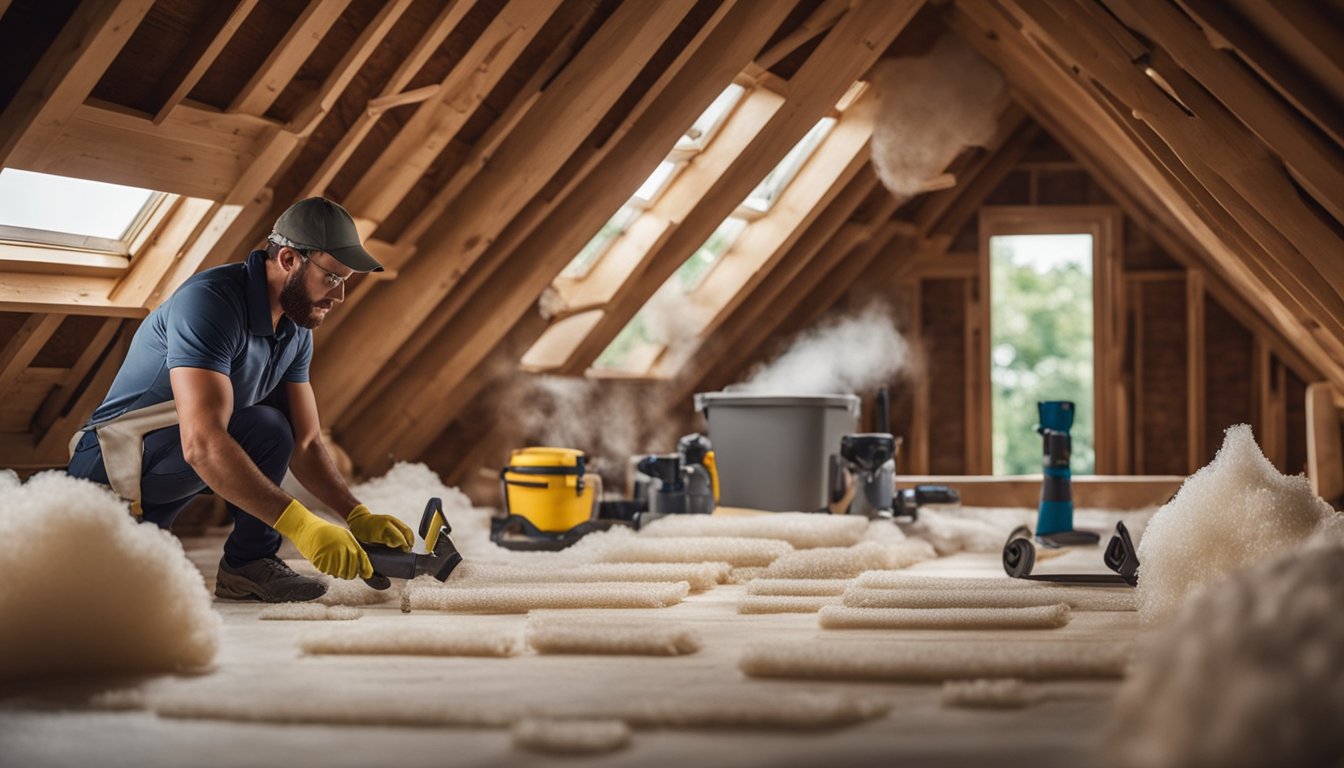Late updated: 30 Nov 2024 12:11
Written by: Oliver Bennett
The Benefits Of Investing In Roof Insulation: Enhancing Energy Efficiency
Investing in roof insulation is more than just a smart financial move; it's a commitment to creating a more energy-efficient and comfortable home environment. By reducing heat loss in winter and minimising heat gain in summer, roof insulation can significantly lower your heating and cooling costs. This is not just about savings, but also about contributing to a greener planet by reducing energy consumption and carbon footprint.

There are a variety of insulation materials available, each offering different levels of thermal resistance, also known as R-value. Choosing the right insulation material and determining the ideal insulation thickness ensures that the benefits of insulation are maximised. It's crucial for homeowners to consider these options when planning their installation to achieve optimal results.
Installing roof insulation requires some practical insights. Whether you're opting for professionally installed or DIY solutions, understanding the types of insulation available, such as loose-fill or rolled blankets, will guide you towards the best choice for your home. Let’s explore the manifold benefits and practical insights on how to make your home more efficient with roof insulation.
Key Takeaways
- Roof insulation reduces heating and cooling costs.
- Different materials offer varied thermal resistance.
- Practical guidance improves insulation effectiveness.
Maximising Energy Efficiency and Comfort with Roof Insulation
Investing in roof insulation plays a pivotal role in enhancing energy efficiency and boosting comfort levels within our homes. By effectively managing heat transfer, tailoring insulation material choices, and reducing energy bills and carbon emissions, we can achieve significant improvements.
Understanding Heat Transfer and Thermal Performance
Heat transfer in buildings occurs through conduction, convection, and radiation. Roof insulation acts as a barrier, slowing down this transfer. The thermal performance of insulation is gauged by R-values, which indicate how well a material resists heat flow.
Materials like fibreglass, mineral wool, and polyurethane foam offer superior resistance. Higher R-values imply better insulation effectiveness, leading to stable indoor temperatures. This stability enhances indoor comfort as it reduces temperature fluctuations, ensuring warmth during winter and coolness during summer. Selecting materials with the appropriate R-value is crucial for optimal thermal performance.
Exploring the Impact on Energy Bills and Carbon Footprint
Properly insulated roofs contribute to noticeable reductions in energy usage. By decreasing the dependency on heating and cooling systems, we can lower our electricity and heating bills. Roof insulation can lead to significant energy savings by maintaining consistent indoor temperatures, making homes more energy-efficient.
Moreover, this energy efficiency translates to a smaller carbon footprint, as less energy consumption means fewer emissions. The environmental benefits are substantial, making insulation a worthy investment not just for cost savings, but for its positive impact on the planet.
Assessment of Insulation Material Options
Choosing the right insulation involves evaluating various materials and their properties. Fibreglass is widely used for its affordability and good R-value. It's non-combustible and resistant to moisture. Mineral wool is another option, known for its superior sound insulation and high temperature resistance.
Polyurethane foam offers excellent insulation with a high R-value and can fill gaps effectively. Polystyrene and polyisocyanurate provide different benefits, such as moisture resistance or higher R-values. Each material presents unique advantages that can be matched to specific needs, ensuring we achieve the desired balance of cost, energy efficiency, and comfort.
Practical Insights for Roof Insulation Installation

Investing in roof insulation involves several considerations that can enhance both the energy efficiency and comfort of our homes. Key variables include deciding between professional installation and DIY, maintaining the structural integrity alongside adequate ventilation, and understanding the impact on property value and air quality.
Professional Installation Versus DIY: Pros and Cons
Opting for professional installation can ensure compliance with building regulations and a high standard of workmanship. Professionals have the experience to handle complex installations such as spray foam or rigid foam insulation, which may involve specific equipment and techniques that we may not possess.
Conversely, opting for a DIY approach can offer cost savings on labour. However, it's crucial we assess our skills honestly, as improper installation can damage the roof's structural integrity, particularly on flat or pitched roofs. Using materials like blanket or loose-fill insulation, which are easier to install, can mitigate some risks if we're confident in our abilities.
Maintaining Roof Structural Integrity and Ventilation
Preserving the structural integrity of our roof during insulation is paramount. We should only use high-quality materials and follow best practices to prevent issues like sagging or water damage. Careful attention must be paid to the roof's support structures and the overall weight of the insulation materials used.
Adequate ventilation must also be maintained to prevent moisture buildup that can lead to mould or rot. Installation techniques that incorporate proper air spaces will help manage airflow, protecting both the roof and the insulation materials. Consulting with organisations like the National Insulation Association can provide valuable guidelines in this area.
Enhancements to Property Value and Indoor Air Quality
Effective insulation significantly increases property value by enhancing energy efficiency, which is a major selling point in today's market. High-quality insulation reduces utility costs and contributes to a more energy-efficient home, appealing to environmentally conscious buyers.
Additionally, proper insulation installation can improve indoor air quality by preventing the infiltration of pollutants and maintaining consistent indoor temperatures. Improved sound absorption and noise reduction are additional benefits. Collaborating with experts ensures the work meets local standards, further safeguarding our investment and enhancing long-term value.
Frequently Asked Questions

Investing in roof insulation can significantly impact energy efficiency, cost savings, and comfort at home. Addressing common questions can help homeowners understand the benefits and considerations involved.
What advantages does loft insulation offer to homeowners?
Loft insulation helps maintain a stable indoor temperature by reducing heat loss in winter and lowering heat gain in summer. This not only enhances comfort but also decreases reliance on heating and cooling systems, leading to reduced energy costs. Homeowners may also find their property value improved due to better energy efficiency ratings.
How does roof insulation impact energy consumption within the home?
Roof insulation acts as a barrier to heat transfer, reducing the need for constant heating and cooling. By minimising energy wastage, it lowers energy consumption, which in turn reduces utility bills. This means less strain on heating and air conditioning systems, prolonging their lifespan.
Can installing insulation in the attic contribute to long-term cost savings?
Yes, attic insulation helps save money over time by decreasing energy bills. Properly installed insulation can cut heating and cooling costs by up to 20%. This makes it a worthwhile investment that pays for itself through energy savings over several years.
What is the expected return on investment for adding roof insulation?
The return on investment (ROI) for roof insulation varies depending on the type and quality of materials used. Generally, homeowners can expect significant savings within a few years as energy costs decline. Energy efficiency improvements can also increase home value, contributing to a positive ROI.
How does enhancing roof insulation improve indoor comfort levels?
Improved roof insulation stabilises indoor temperatures, eliminating drafts and preventing hot or cold spots. This results in a more comfortable living environment, regardless of external weather conditions. Effective insulation also aids in soundproofing, reducing outdoor noise intrusion.
In what ways does roof insulation contribute to a building's energy efficiency?
Roof insulation improves energy efficiency by minimising heat transfer between the interior and exterior. This reduces the demand on heating and cooling systems, which leads to lower energy consumption. A well-insulated roof can significantly enhance a building's overall energy efficiency, leading to a smaller carbon footprint.
